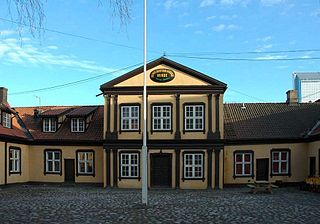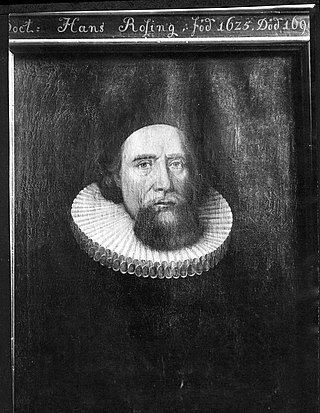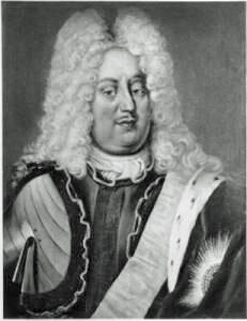
Fredriksten is a fortress in the city of Halden in Norway.

Akershus Fortress or Akershus Castle is a medieval castle in the Norwegian capital Oslo that was built to protect and provide a royal residence for the city. Since the Middle Ages the fortress has been the namesake and centre of the main fief and later main county of Akershus, which was originally one of Norway's four main regions and which included most of Eastern Norway. The fortress itself was located within the Akershus main county until 1919, and also within the smaller Akershus sub county until 1842.

Fortification Upgrades (1673–1675) was a re-organization of military forces and strengthening of the defenses of Norway. The Norwegian army in this period became much better prepared for conflict with Sweden than in any previous period. It numbered 12,000 men in five regiments of infantry, 6 companies of cavalry, and an artillery division with 76 field pieces. An additional Norwegian regiment was serving in Denmark.

The Great Northern War was the war fought between a coalition of Denmark–Norway, Russia and Saxony-Poland on one side and Sweden on the other side from 1700 to 1721. It started by a coordinated attack on Sweden by the coalition in 1700, and ended 1721 with the conclusion of the Treaty of Nystad, and the Stockholm Treaties. As a result of the war, Russia supplanted Sweden as the dominant power on the shores of the Baltic Sea, becoming a major player in European politics.

Ulrik Frederik Gyldenløve, Landgrave of Laurvig was Governor-general of Norway from 1664–1699. He was the leading general in Norway during the Scanian War, whose Norwegian leg is conventionally named the Gyldenløve War after him. In Norway he was also the Landgrave of Laurvig.

The Torstenson War was fought between Sweden and Denmark–Norway from 1643 to 1645. The name derives from Swedish general Lennart Torstenson.

Frederik Gottschalk von Haxthausen was a Danish-Norwegian army officer, councillor of state, cabinet member and Norway's first minister of finance.
Anthony Coucheron was an engineering officer. Coucheron played an important role in the history of Norwegian and Danish fortifications. As Sweden grew to be a great power in the 17th century, there were frequent wars in the Baltic region, and conflict was common along the borders between Sweden & Denmark-Norway. Easy invasions routes from Sweden were fortified on the Danish-Norwegian border with new or upgraded fortresses during this period, effectively establishing the modern borders between Norway & Sweden. Anthony Coucheron played a major role in fortification of the border, both in Norway and Denmark in addition, he participated with honor in combat during the Gyldenløve War.
Vincens Budde was a Norwegian officer, born in 1660 in Halden, Norway into a Norwegian military family. Budde was promoted to colonel 1710 and to major general in 1716.
The military history of Norway commences before the Viking Age with the internal wars fought between regional kings to obtain the supreme kingship of the whole of Norway. The most famous period of Norwegian history and thus military history is the Viking Age, but the early Middle Ages was the era when Norwegian military power in Europe reached its peak. Since then the Norwegian military has experienced long periods of neglect, but also rearmament and victories.

Henrich Krummedige, was born circa 1464 in Norway and died in 1530. He was a Danish-Norwegian nobleman and a member of both the Norwegian and Danish National Councils (Rigsråd) and played an extensive role in the politics of the era. He served as commanding officer of the Bohus Fortress in Norway from 1489 to 1503.

Johan Vibe was a Danish military officer and engineer, who was appointed Governor-General of Norway from 10 April 1708 until his death.

The siege of Fredriksten was an attack on the Norwegian fortress of Fredriksten in the city of Fredrikshald by King Charles XII of Sweden. While inspecting his troops' lines, Charles XII was killed by a projectile. The Swedes broke off the siege, and the Norwegians held the fortress. Along with the Treaty of Nystad three years later, the death of Charles XII marked the end of the imperial era in Sweden, and the beginning of the Age of Liberty in that country.

Gyldenløve was a surname for several illegitimate children of Oldenburg kings of Denmark-Norway in the 17th century.

Prinds Christian Augusts Minde was an asylum, workhouse and social institution located at Storgata 36 in downtown Oslo, Norway.

Hans Rosing was a Norwegian clergyman. He served as Bishop of the Diocese of Oslo from 1664 until 1699.
Events in the year 1712 in Norway.
Frederik Gabel (1645–1708) was a Danish-Norwegian nobleman who served as Vice Governor-general of Norway from 1699 until his death in 1708.
Niels Toller was a Danish-born merchant who settled in Norway and became the wealthiest person in Christiania.

Carl von Ahlefeldt was a German-Danish statesman. He was a stadtholder and by birth a member of the House of Ahlefeld. He was part of the inner circle around Frederick IV until 1712 and then became Governor-general of Slesvig-Holsten.














